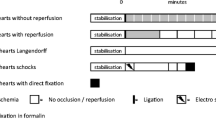Summary
In open-chest dogs, the left anterior descending coronary artery was ligated for 150 min. The heart was semiserially cut on a cryomicrotome and areas of ischemic damage were visualized by means of glycogen depletion (PAS reaction) and tissue acidosis (a “sandwich” technique with pH indicator dispersed in a layer of gel). The extent of myocardial damage was determined morphometrically.
The mass of the glycogen-depleted heart muscle was greater than the mass of the ischemic tissue detected by means of decreased pH (p<0.01). The border zone was characterized by glycogen depletion without acidosis.
Circulation studies using intravital fluorescein staining have shown that perfusion is partially retained in the border zone; it is assumed that the hypoperfusion triggers glycogenolysis. Nevertheless, the level of perfusion suffices to wash out the acidic end products.
Comparison of contrapulsation-treated dogs and untreated dogs shows that the amount of damaged tissue comprising the border zone can be reduced by this therapeutic intervention (p<0.02)—in contrast to the acidotic tissue, the amount of which is not significantly influenced. Therefore the border zone contains damaged but still viable muscle cells.
Similar content being viewed by others
References
Bollinger A, Jäger K, Roten A, Timeus Ch, Mahler F (1979) Diffusion, Pericapillary Distribution and Clearance of Na-Fluorescein in the Human Nailfold Pflügers Arch 382:137–143
Dunnill MS (1962) Quantitative methods in the study of pulmonary pathology. Thorax 17:320–328
Fox AC, Hoffstein S, Weissmann G (1976) Lysosomal mechanism in production of tissue damage during myocardial ischemia and effects of treatment with steroids. Amer Heart J 91:394–397
Gevers W (1977) Generation of protons by metabolic processes in heart cells. J Mol Cell Cardiol 9:867–874
Harken AH, Barlow Ch, Harden WR, Chance B (1978) Two and three dimensional display of myocardial ischemic “border zone” in dogs. Amer J Cardiol 42:954–963
Hearse DJ, Opie LH, Katzeff IE, Lubbe WF, Van der Werff TJ, Peisach M, Boulle G (1977) Characterization of the “border zone” in acute regional ischemia in the dog. Amer J Cardiol 40:716–726
Hirzel HO, Sonnenblick EH, Kirk ES (1977) Absence of a lateral border zone of intermediate creatine phosphokinase depletion surrounding a central infarct 24 hours after acute coronary occlusion in the dog. Circulat Res 41:673–683
Janse MJ, Cinca J, Moréna H, Fiolet JWT, Kléber AG, DeVries GP, Becker AE, Durrer D (1979) The “border zone” in myocardial ischemia. An electrophysiological, metabolic, and histochemical correlation in the pig heart. Circulat Res 44:576–588
Khuri SF, Kloner RA, Hillis LD, Tow DE, Barsamian EM, Maroko PR, Braunwald E (1979) Intramural PCO2: A reliable index of the severity of myocardial ischemic injury. Amer J Physiol 237:H253-H259
Krug A (1965) Der Frühnachweis des Herzinfarktes durch Bestimmung der Wasserstoffionenkonzentration im Herzmuskel mit Indikatorpapier. Virchows Arch path Anat 338:339–341
Krug A (1975) Alterations in myocardial hydrogen ion concentration after temporary coronary occlusion: A sign of irreversible cell damage. Amer J Cardiol 38:214–217
Maroko PR, Deboer LWV, Davis RF (1980) Infarct size reduction: A critical review. In: Vogel JHK (ed) Advances in Cardiology, Vol 27, pp 127–169. S. Karger AG, Basel
Neely JR, Whitmer JT, Rovetto MJ (1975), Effect of coronary blood flow on glycolytic flux and intracellular pH in isolated rat hearts. Circ Res 37:733–741
Opie LH, Brunyeel K, Owen P (1975) Effects of glucose, insulin and potassium infusion on tissue metabolic changes within first hour of myocardial infarction in baboon. Circulation 52:49–57
Opie LH (1976) Effect of regional ischemia on metabolism of glucose and fatty acids. Relative rates of aerobic and anaerobic energy production during myocardial infarction and comparison with effects of anoxia. Circ Res 38(Suppl 1):52–74
Opie LH, Owen P (1976) Effect of glucose-insulin-potassium infusions on arteriovenous differences of glucose and of free fatty acids and on tissue metabolic changes in dogs with developing myocardial infarction. Amer J Cardiol 38:310–321
Schaper J (1979) Correlation between ultrastructure and interstitial pH of isolated human papillary muscle. J Mol Cell Cardiol 11(Suppl 1):54
Scheuer J (1967) Myocardial metabolism in cardiac hypoxia. Amer J Cardiol 19:386–387
Sládek T, Vašků J, Urbánek E, Filkuka J, Doležel S, Wendsche P, Hartmannová B, Šotolová O (1980) Reperfusion of coronary arteries after temporary occlusion in dogs. J Cardiovasc Surg 21:695–702
Vokonas PS, Malsky PM, Paul SJ, Robbins SL, Hood WB (1978) Radioautographic studies in experimental myocardial infarction. Profiles of ischemic blood flow and quantification of infarct size in relation to magnitude of ischemic zone. Amer J Cardiol 42:67–75
Williamson JR, Schaffer SW, Ford C, Safer B (1976) Contribution of tissue acidosis to ischemic injury in the perfused rat heart. Circulation 53(Suppl 1):3–14
Author information
Authors and Affiliations
Rights and permissions
About this article
Cite this article
Sládek, T., Filkuka, J., Doležel, S. et al. The border zone of the early myocardial infarction in dogs; its characteristics and viability. Basic Res Cardiol 79, 344–349 (1984). https://doi.org/10.1007/BF01908035
Received:
Issue Date:
DOI: https://doi.org/10.1007/BF01908035



